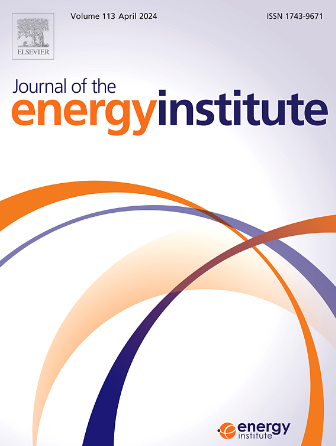Insight into the instability of ammonia-methane laminar diffusion flame
IF 5.6
2区 工程技术
Q2 ENERGY & FUELS
引用次数: 0
Abstract
Ammonia is one of carbon-neutral hydrogen derivatives and is identified as a sustainable fuel for mobile applications. However, the combustion instability of pure ammonia remains a significant challenge. In this study, the combustion instability of ammonia flame with methane as a combustion promoter was investigated using high-speed photography and schlieren techniques on ammonia-methane-air co-flow laminar diffusion flames. It was found that after exceeding a threshold of fuel flow rate (Qf), the stable laminar flame turned to a regular and reproducible oscillation, accompanying by periodic bulging and separation of the flame. The addition of co-flow air increases flame flickering frequency, which can be reduced by increasing the Qf. In contrast to the pure methane diffusion flame with distinct luminous zones, the NH3/CH4 diffusion flame exhibits a reddish-orange color with no distinguishable luminous zone. Additionally, the addition of ammonia shrinks the appearance of flames, and slightly decreases the flame flickering frequency at 30 % substitution, while increases it at 50 % substitution. A spindle-shape shear layer between the flame and the surrounding air, exhibiting periodic motion during the flickering sequence. The addition of ammonia decreases the maximum shear layer diameter and increases its motion velocity. The co-flow air pushes the vortex formation location downstream, reducing fluctuation amplitude of the shear layer. Ammonia substitution further promotes this downstream shift, potentially lessening the flame flickering.

求助全文
约1分钟内获得全文
求助全文
来源期刊

Journal of The Energy Institute
工程技术-能源与燃料
CiteScore
10.60
自引率
5.30%
发文量
166
审稿时长
16 days
期刊介绍:
The Journal of the Energy Institute provides peer reviewed coverage of original high quality research on energy, engineering and technology.The coverage is broad and the main areas of interest include:
Combustion engineering and associated technologies; process heating; power generation; engines and propulsion; emissions and environmental pollution control; clean coal technologies; carbon abatement technologies
Emissions and environmental pollution control; safety and hazards;
Clean coal technologies; carbon abatement technologies, including carbon capture and storage, CCS;
Petroleum engineering and fuel quality, including storage and transport
Alternative energy sources; biomass utilisation and biomass conversion technologies; energy from waste, incineration and recycling
Energy conversion, energy recovery and energy efficiency; space heating, fuel cells, heat pumps and cooling systems
Energy storage
The journal''s coverage reflects changes in energy technology that result from the transition to more efficient energy production and end use together with reduced carbon emission.
 求助内容:
求助内容: 应助结果提醒方式:
应助结果提醒方式:


